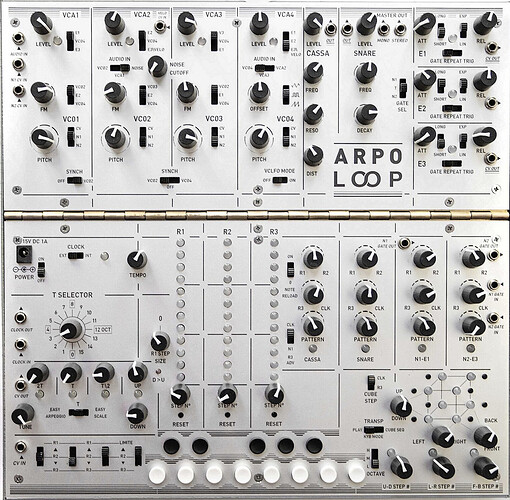I was just scouting around last night looking at the leploop and came across their new product coming out soon, looks interesting, the Arpoloop
“developer Peppo Lasagna”
Oh, come on, they’re trolling us
L.E.P. will be at Machina Bristronica ( thread ) so look for the Arpoloop there.
Seems like nobody noticed, but Arpoloop is now ready for preorder!
I have tested the machine at Superbooth 2024 and it’s great. Tony and I talked for quite a while about the development process. They pivoted a few times with the design and have added another small melody sequencer in bottom right corner.
Here are some insights from trying the machine:
The bottom half of the machine is all sequencer, and a very creative one. Tony spoke of it as an ‘analog computer for musicians’ and they are also calling it an ‘Analog Intelligent Algorithm’.
It definitely feels alive.
At the right, it has 4 channels of rhythm generation, which are triggered off of the ramps R1-R3 (LEDs in middle). Ramps can have their number of steps set, and there is also a reset button for each ramp.
The triggering works like this: for each channel you can mix between R1-R2 and R3-Clock. All of these are stair-shaped voltages. The ‘PATTERN’ knob sets a threshold, the channel triggers when that’s exceeded. It’s kind of genius because it leads to some very interesting patterns, especially when the ramps are out of phase. Most importantly, the patterns produced are not random, and feel kind of musical.
The left part (labeled “T”) is a melody sequencer, and a strange one. It seems to be based on a voltage memory cell, whose value can be doubled, halved, or incremented/decremented on a trigger which is again related to the ramps. Have to say I couldn’t figure out how this works exactly.
In the bottom right corner, there is a ‘cube sequencer’, which holds programmable note values. To program, one has to hold one of the buttons next to the LED and press a key. It steps through the cube based on triggers. The output of the cube seq can be used to transpose, and it’s also available as a separate CV signal for controlling the oscillators. Difference between the two melodic sequencers is that one is chaotic, and the other one is programmed. Both can be active at the same time.
The top half of the machine, which can be flipped up, has 4 VCAs, 3 AR envelopes, and 4 oscillators. Osc 1-3 are sine waves with sync and linear FM. Very nice raspy sound. Osc 4 has switchable wave shapes and can also be used as LFO. There is also a noise source. Overall sound of the oscillator section is way softer than Leploop because of the sine wave osc shape.
The percussion channels aren’t that special I think, they’re basically the same circuits which are also in Multicassa, Leploop, etc.
It looks really cool but I’m having a hard time to really hear how it can sound. YouTube demos are not very explanatory and mixed with other eurorack modules.
I’m not nobody.
Sorry maybe shouldn’t have written it like that. I was just wondering since it wasn’t mentioned by anyone in the Superbooth thread, and no news about it from synth magazines coverage either. To be fair, L.E.P. booth was kind of hard to find, I walked past it at first.
Yeah, the demos from Tony are weird and it’s always camera audio. Why he does that is beyond me. He did say they want to produce some proper demos/instruction videos later.


